How do your leaders like to learn? It’s an important question to ask when choosing and implementing leadership development programs. Why? Because even the most thoughtful and focused leadership programs can miss the mark if leaders aren’t engaged with their learning methods. So, what are the best leadership training types for your leaders? I’ll answer this question and others in this blog. But before we get into what types of leadership training matter, allow me to share a story of why leadership training matters.
Why Leadership Training Matters
“…to create a safe working environment…”
That was how one senior leader responded when I asked why leadership development mattered to him. From there, other stories followed. Each leader described personal experiences of safety mishaps, some resulting in people getting hurt, and in the most tragic circumstances, loss of life. These stories connected leaders together and to the program’s purpose.
Listening to the stories these leaders shared, I felt a pull on the inside. Our mission is about much more than helping leaders conclude a training course. It’s about changing the way people interact with each other. To help organizations strengthen their safety culture and create empathetic, focused leaders. Better leadership meant a safer future.
This company recognized that their leaders influenced the tone, culture, and mindset for everything, especially when it came to safety. They launched their development program in areas across the organization where leaders had little to no formal leadership training. Together, we designed the leadership program to deliver formal in-person training onsite, leveraging relevant and real workplace scenarios. This design allowed leaders to practice newly learned knowledge and skills with each other, and exchange feedback and personal experiences.
The safety agenda and the population being in an industrial setting played a role in the decision to run in-person classes. Discussing challenges in their workspace, with facilitators who understood their real-world challenges, made a difference. In many ways, this was a change agenda. Instructor-led learning enabled the leaders to share their perspectives and understand the important social aspect in learning, all while building a common leadership language.
Creating a safe working environment became the guiding principle for the program. And it made a big difference. By building and practicing interpersonal and leadership skills, the organization made its operation safer for all employees. As this organization looked to sustain their great work, self-paced learning, refreshers, and assessment tools were on the horizon.
So, before you dive into what or how your leaders should learn, make sure you connect to the “why.” From that “why,” you can create a thoughtful program that leaders truly want. Which brings us to our next topic: What are the best leadership training types?
The Best Leadership Training Types
It can be daunting for HR and talent professionals to decide between all the learning methods and modalities available. To help you better connect to your leaders, let’s explore their needs. In our Global Leadership Forecast (GLF) 2023, we surveyed 1,827 human resource professionals and 13,695 leaders from 1,556 organizations worldwide. In this research, we asked what types of training experiences leaders want most. Here are what leaders consider to be the best leadership training types:
- Instructor-led training
- Professional coaching
- Assessment to inform development
- Developmental assignments
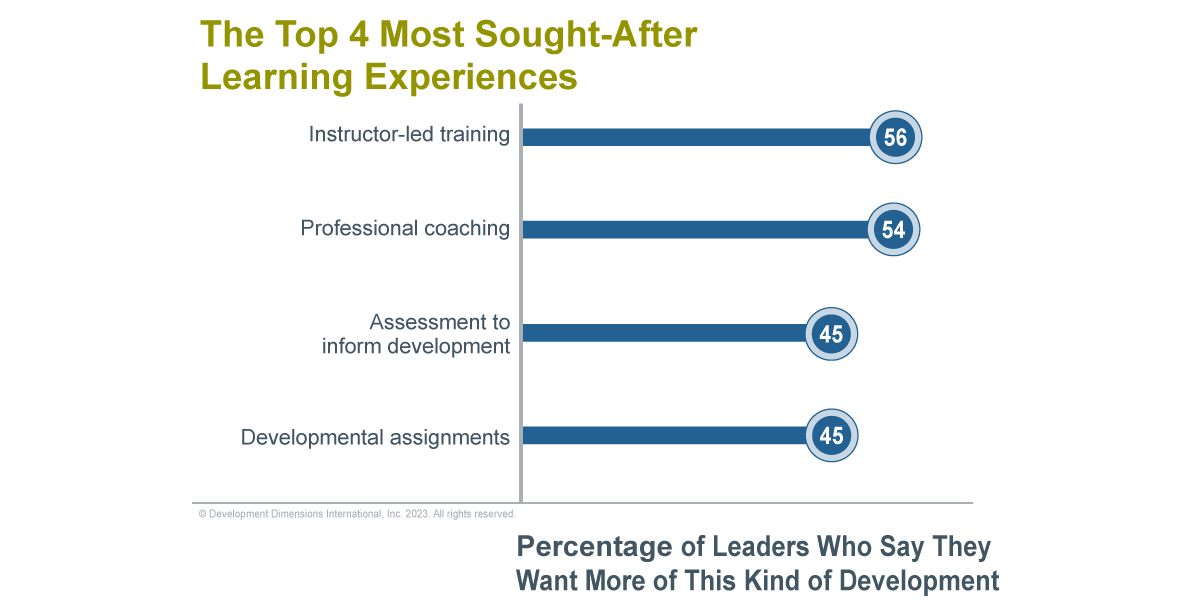

1. Instructor-Led Training
Learners greatly benefit from facilitated training sessions. This preference may come as a surprise. In the era of digital, on-demand everything, many people may assume that developing leaders are looking to learn on their own, on their own time. But our research highlights that 56% of leaders said they wanted more instructor-led training. And a whopping 71% of high-potential leaders want instructor-led training to strengthen leadership skills. Why?
Because it’s engaging. Leaders learn best when they have a teacher and peer learners. People who talk about learning trends often assume that learners have a higher interest in games and technology-based learning. But leaders also want social and interactive classroom experiences with facilitators and peers.
To be clear, instructor-led training doesn’t have to occur in person. You can create engaging, live virtual classroom experiences when your leaders are working from home or on opposite sides of the world. This finding also tells us that leaders are craving more face-to-face moments, so finding opportunities to bring leaders together is important. Doing this will not only help leaders reconnect, but also let them reap the benefits of informal learning, like building networks, creating visibility, and exchanging ideas.

2. Professional Coaching
Leaders also prefer to have professional coaching experiences. 54% of leaders want professional coaching to help them grow their skills. They crave the input of professional coaches because they gain highly personalized learning experiences from these sessions. Meeting 1:1 with someone who will help them identify challenges, provide feedback, and put together a specific development plan is something leaders find immense value in. It's easy to see why people like the idea of professional coaching since it's guaranteed to be very relevant to leaders and the problems they face today.
Despite a high percentage of leaders stating professional coaching as a learning preference, fewer organizations are focusing on coaching for development. In fact, coaching culture has dramatically decreased since 2020. But offering professional coaching gives companies the opportunity to improve retention and create meaningful development experiences for their leaders. Organizations can build a coaching culture without a professional coaching strategy by training leaders and individual contributors to use a coaching approach in how they relate to and provide feedback to each other.
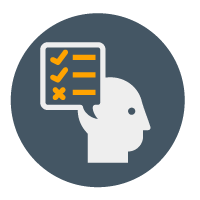
3. Assessment to Inform Development
The trend of wanting deeply personalized guidance is extended when you consider the value of leadership assessments. Assessments can provide personalized insight into your own skills, and act as a road map to help individuals tailor their own development. There are a wide range of types of leadership assessments, and nearly all of them can help guide development plans.
Examples include self-insight tools to heighten awareness of your personal profile and mindset, or in-depth behavioral feedback and simulations. We’ve learned that 56% of high-potential leaders want to use assessment to diagnose strengths and areas for improvement. This is because assessments are deeply personalized and help leaders commit and engage more deeply in their learning experience.
I'm not sure that I would describe assessment as giving someone professional input or an outside eye. Assessment usually involves taking an objective survey to understand your strengths and developmental areas. But not necessarily talking with a professional, like a coach or instructor. What assessment does do is give you completely personalized insight into your own skills. Feedback can be so powerful in telling you where to focus. And that leads to development planning.

4. Developmental Assignments
Developmental assignments help leaders and emerging leaders learn through experience and apply what they’ve learned. Leaders’ learning preferences showed they want opportunities to apply their skills to new challenges. High-potential leaders in particular are aware that their skills are in demand and are interested in gaining new experiences. In the absence of formal role promotions, engaging developmental assignments can help retain them, especially since three years is the critical tipping point for these valuable leaders to start showing interest in moving on. I often ask clients the following questions to help them check their developmental assignments for relevance:
- What new skills will leaders need to apply in this assignment?
- Will these assignments help leaders address challenges they face now and in the future?
- What will leaders have the opportunity to learn from these assignments?
- How will you and your organization support this learning effort?
Consider also setting development assignments that help connect back to your program's purpose and communicate the impact in success stories. For example, the organization I referenced earlier tasked leaders with answering how they would apply learnings to reduce the likelihood of repeated safety incidents. They engaged in an analysis exercise that also involved a retro of previous safety fatalities, and prioritized actions they would take in their own workplace, now. This simple exercise resulted in leaders applying new skills to improve safety.
What makes a leadership course great?
In order to be effective, any type of training must create a leader-first experience. Put leaders at the center of development by leveraging DDI’s five design principles.
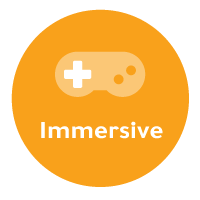
1. Immersive
Great leadership training creates powerful and memorable experiences, renews energy, builds skills, and increases confidence. When leaders learn by doing, they experience real challenges firsthand. With practice and feedback in a safe environment, leaders build self-awareness and strengthen their skills.
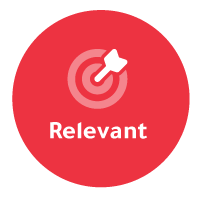
2. Relevant
What challenges do your leaders have? The company I partnered with leveraged data and input from stakeholders to determine focus areas and skills taught in the program. They ensured leaders learned skills they needed immediately to solve real-life safety challenges.
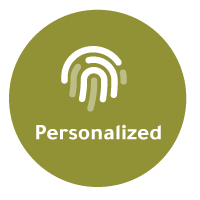
3. Personalized
Everyone is unique. A great program is one which helps leaders see the value of the experience for themselves. They could be gaining insight about their strengths or development areas through an assessment. Or work on their specific challenges in classroom breakout sessions or get a say in how they prefer to learn.
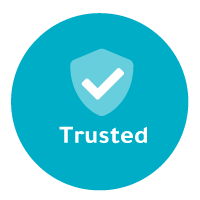
4. Trusted
A leadership development curriculum must be credible. It should be rooted in science with a track record of success helping organizations develop great leaders. This helps build a common leadership language you can trust, that will have a positive impact on your organization's goals.

5. Human
Above all, leadership is intensely human. And this human aspect of learning should be applied to leadership training. People want to feel the emotional connection and consequences of their actions. Programs that engage both the heart and mind will make leadership development more authentic and help leaders connect to themselves and others on a deeper level.
Together, these five principles contribute to a leadership development experience that is truly relevant, connected, contextual, and personalized. When these principles are combined with the best leadership training types for your leaders, you are sure to see impact.
Is there value in combining multiple training types?
Many companies are tempted to focus on one training type with their program offerings. For example, they’ll create a program that’s entirely self-directed online, or entirely based on formal classroom learning, or wholly relying on outside coaches. One thing we know is that people learn better when there’s variety in a learning journey. And there is perhaps no better way to have variety than through blended learning experiences.
Blended learning is the idea that different learning types serve to mutually reinforce, support, and build on each other while keeping participants engaged. And it is essential for development to meet leaders where they are in their moment of need. Leaders will likely need on-demand, self-paced options combined with formal programs to feel supported with their challenges.
Designing a blended learning journey can seem daunting, especially with the overwhelming number of options. But don’t let this deter you! Many people find value in blended learning’s practical flexibility and general ease when implementing a program with different training types.
Top training programs meet leaders in the moment.
Meeting leaders in the moment means thinking about the challenges they face and how their preferred training types can help meet them where they are. For example, someone stepping into a new leadership role might be looking for formal classroom-based development to help them gain fundamental skills. Meanwhile, a seasoned business leader who’s struggling with an urgent problem, like addressing conflict with a team member, might need resources immediately.
In the case of the story I shared earlier, context was key. Safety incidents and fatalities highlighted a need to focus their strategy. It was essential to equip their leaders with the core skills to put safety first. Thinking about their audience and the best leadership training types for their leaders propelled them to prioritize instructor-led learning.
They blended face-to-face classroom sessions using real-life scenarios, cohort-based learning, and personalization using self-assessments. To meet continued moments of need and sustainment, they expanded into refreshed, self-directed, and accessible resources for just-in-time support. They mandated a program for a specific population of their leaders and engaged their business to see the value and benefits. Consider what challenges are critical for your business and leaders. Then, create a development strategy that can support those needs.
Leadership training makes a profound difference.
At the heart, every leader is trying to do their best in an environment full of opportunities and challenges. And organizations need to focus on supporting these leaders, because investing in the right development can make a significant difference— for both leaders and the organization. Consider the purpose of your leadership training program and listen to the needs of your business. Do this all while keeping the best leadership training types for your leaders and employees in mind.
Your program will only be successful if learners engage with the material. So, opting for training types that appeal to learners is critical for high adoption. Your vision could be to create more inclusive leadership culture, build an empowered workforce, boost employee engagement, or create a safer place to work. Whatever your vision for leadership development is, the right training can make it a reality.
Get more research by downloading the Global Leadership Forecast 2023.
Katy Freeman is a product manager at DDI. She’s deeply interested in the persona and needs of leaders—leveraging this insight to support thought leadership and content strategy. When not immersed in leadership, you can find Katy adding a travel destination to her bucket list or exploring different yoga practices.
Topics covered in this blog

